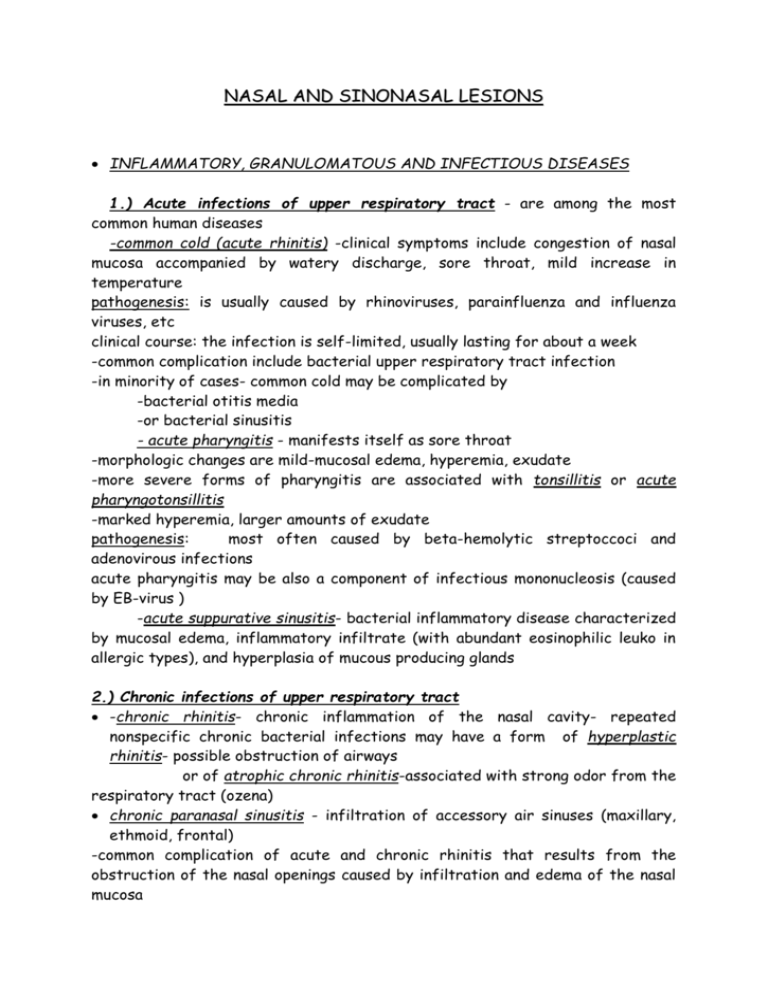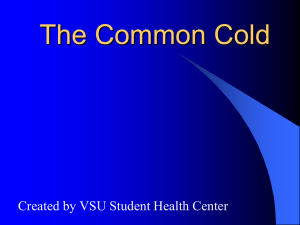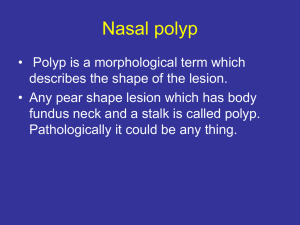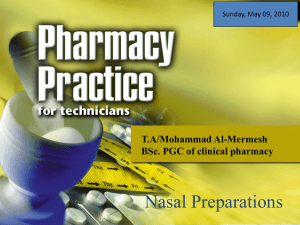Nasal And Sinonasal Lesions
advertisement

NASAL AND SINONASAL LESIONS INFLAMMATORY, GRANULOMATOUS AND INFECTIOUS DISEASES 1.) Acute infections of upper respiratory tract - are among the most common human diseases -common cold (acute rhinitis) -clinical symptoms include congestion of nasal mucosa accompanied by watery discharge, sore throat, mild increase in temperature pathogenesis: is usually caused by rhinoviruses, parainfluenza and influenza viruses, etc clinical course: the infection is self-limited, usually lasting for about a week -common complication include bacterial upper respiratory tract infection -in minority of cases- common cold may be complicated by -bacterial otitis media -or bacterial sinusitis - acute pharyngitis - manifests itself as sore throat -morphologic changes are mild-mucosal edema, hyperemia, exudate -more severe forms of pharyngitis are associated with tonsillitis or acute pharyngotonsillitis -marked hyperemia, larger amounts of exudate pathogenesis: most often caused by beta-hemolytic streptoccoci and adenovirous infections acute pharyngitis may be also a component of infectious mononucleosis (caused by EB-virus ) -acute suppurative sinusitis- bacterial inflammatory disease characterized by mucosal edema, inflammatory infiltrate (with abundant eosinophilic leuko in allergic types), and hyperplasia of mucous producing glands 2.) Chronic infections of upper respiratory tract -chronic rhinitis- chronic inflammation of the nasal cavity- repeated nonspecific chronic bacterial infections may have a form of hyperplastic rhinitis- possible obstruction of airways or of atrophic chronic rhinitis-associated with strong odor from the respiratory tract (ozena) chronic paranasal sinusitis - infiltration of accessory air sinuses (maxillary, ethmoid, frontal) -common complication of acute and chronic rhinitis that results from the obstruction of the nasal openings caused by infiltration and edema of the nasal mucosa -chronic inflammatory and allergic nasal polyps -repeated attacks of acute rhinitis may result in the development of inflammatory nasal polypspseudotumors composed of edematous stroma, abundant inflammatory cells, including neutrophils, eosinophils, lymphocytes and plasma cells, eosinophils are more numerous in allergic nasal polyps -nasal polyp may cause nasal obstructionnasal polyps are soft, edematous, semitranslucent polypoid masses affecting nasal cavity, usually associated with acute and chronic rhinitis and sinusitis -antrochoanal polyps- between 3 to 6% of all patients with nasal inflammatory polyps have the antral-choanal variety -It is usually solitary, nasal obstruction and epistaxis are the major symptoms Choanal polyps are defined as paranasal sinus polyps that pass through sinus ostia and protrude into the boundary between nasal cavity and nasopharynx, called choana -rare inflammatory polyps arising in the mucosa of maxillary sinus (antrum Highmori), it protrudes into posterior nasal cavity, can easily become traumatized- ulceration, bleeding, neovascularization- may mimic hemangioma, hemangiopericytoma, juvenile angiofibroma, etc. Most choanal polyps originate in the maxillary sinus. With enlargement the antrochoanal polyp protrudes through the middle meatus into the nasal cavity between middle turbinate and lateral wall of the nasal cavity. Even posterior extension moves polyp into the nasopharynx, very large polyps may present as oropharyngeal mass. Sphenochoanal polyp develops in the sphenoid sinus and protrudes through sphenoid ostium into the nasal cavity rhinoscleroma- is an uncommon chronic infection of ther upper respiratory tract- endemic in eastern Europe (Poland), the Middle East, Central Africa, and Latin America -it its caused by Klepsiella rhinoscleromatis morphology: rhinoscleroma affects the mucous membranes of the nasal cavity and later may extend to nasopharynx and larynx, it presents with polypoid mucosal lesions caused by accumulation of foamy macrophages (Miculizc cells) filled with bacteria and lymphoplasmacytic infiltration in nasal mucosa- result in formation of polypoid masses and ulcerations-the overlaying epithelium may be intact, or squamous metaplasia and pseudopitheliomatous hyperplasia is seen fungal sinusitis- noninvasive fungal sinusitis exists in the form of mycetoma- most commonly caused by aspergillus- these organisms normally occur on the mucosal surfaces of nasal cavity and paranasal sinuses but rarely cause disease -in patients with chronic sinusitis and poor drainage of paranasal sinusesaspergilli may proliferate and produce aspergilloma -invasive fungal sinusitis- affects immunosupressed or immunocompromized patients, those with severe debilityting metabolic and neoplastic diseases Wegener´s granulomatosis- is a rare disease that affects respiratory tract, lungs and kidneys -the clinical presentation is characterized by large sinonasal mucosal non-healing ulcerations, and extensive necroses -septal perforation, and edema, with mucosal swelling can be seen -these clinical features have been reffered to as lethal midline granuloma -lesions of the nasal and paranasal mucosa are the most common and the most characteristic of the disease -in upper respiratory tract- there are lesions characterized by necrotizing destructive granulomas- associated with severe vasculitis pathogenesis: is a form of necrotizing allergic vasculitis -in most patients (85-95%) have a positive test for ANCA antibodies (antineutrophil cytoplasmic antibodies) TUMORS OF NASAL CAVITY AND PARANANASAL SINUSES -introduction- carcinomas of nasal cavity and paranasal sinuses account for 0.2 to 0.8% of all malignant neoplasms and aprox. 3% of tumors of head and neck etiology: occupational exposure to wood dust is known as a risk factor Benign tumors: - scheiderian papilloma-the most common benign tumor of the mucosa of nasal and paranasal cavities (schneiderian membrane) -histologically composed of exyphytic papillary protrusions made up of fibrovascular stromal papillae covered by benign stratified squamous epithelium -common manifestation - is epistaxis (bleeding from the nasal mucosa) and/or obstruction- removed surgically -inverted papilloma -is a variant of schneiderian papilloma in which the epitheliumprolifeates into the underlaying stroma- endophytic growth pattern -has slightly more common local recurrences malignant tumors rare, they include a wide spectrum of tumors with variable clinical outcomes more common include squamous cell carcinoma, lymphoma and plasmocytoma squamous cell carcinoma- located in nasal vestibule or at mucocutaneus junction of the septum clinical symptoms- nasal fullness, obstruction, epistaxis, pain, paresthesia, persistent and non-healing mucosal ulceration, etc. -clinical course is indolent, lymph node meta occur in less than 10% SCC of paranasal sinuses more aggressive (the most common- maxillary sinus) - SCC is classified to keratinizing, nonkeratinizing, papillary and verrucous types- warty, papillary subtype with better clinical outcome- no metastases, rarely recur Sinonasal adenocarcinoma- these are glandular malignancies arising from the glands of respiratory mucosa - Two main categories include intestinal type adenocarcinoma -similar to colorectal adenocarcinoma histologically, causal relationship of wood dust with development of ca has been demonstrated, aggressive tumor with frequent local recurrence (50%), less commonly LN meta, distant meta are rare - Non-intestinal type adenocarcinoma-low grade and high grade lesions Lymphoepithelial carcinoma- is a poorly differentiated SCC or undifferentiated ca accompanied by heavy lymphoid infiltrate, strong associatiation with EBV infection Small cell carcinoma- histologically similar to pulmory ca, common mitoses and necroses, poor prognosis Most carcinomas of the nasal cavity and paranasal sinuses are locally aggressive, they grow readily to adjacent structures Olphactory neuroblastoma- malignant neuroectodermal tumor that originates from olphactory membrane of the sinonasal tract Treatment- safe surgical margins Extranodal T/NK lymphoma of nasal type- is characterized by diffuse lymphoid infitrate causing destruction of mucosa, poor prognosis Lethal midline granuloma -this term was originally applied to a group of diseases characterized by severe destructive ulcerations in the middle of the face including the nasal cavity -most of the cases of LMG (if Wegener and rare fungal infections were excluded) represents sinonasal T-cell lymphoma of type microscopically: characterized by diffuse infiltration composed of atypical lymphoid tumor cells accompanied by extensive tissue necroses and ulcerations of the surface of the mucosa (caused by angiodestructive growth of this type of lymphoma) Extramedullary plasmocytoma- is slowly growing mass lesion composed of mature IgG producing neoplastic plasma cells Prognosis is good, only 20% develop multiple myeloma







